Perception of physician students about studying English with native and non-native english-speaking teachers
Teachers play an important role in the classroom, especially in teaching a
foreign language. This paper reports on the students’ perception of choosing
native or non-native English teachers when learning English using the
questionnaire as a research method. Twenty-four physician students in the
second year at Saigon Polytechnic College joined this study in January,
2016. The result showed that physician students preferred learning listening
(62.5%), speaking (58.3%), reading (54.2%) and pronunciation (75.0%) with
native English-speaking teachers. For grammar and writing, most of them
(87.5%) indicated the preference to study with non-native English-speaking
teachers. Therefore, Rector of the College and Dean of English Department
should take into consideration the importance of teachers in teaching
English for students. Further research with a larger sample size and long
term should be conducted to support this study’s result.
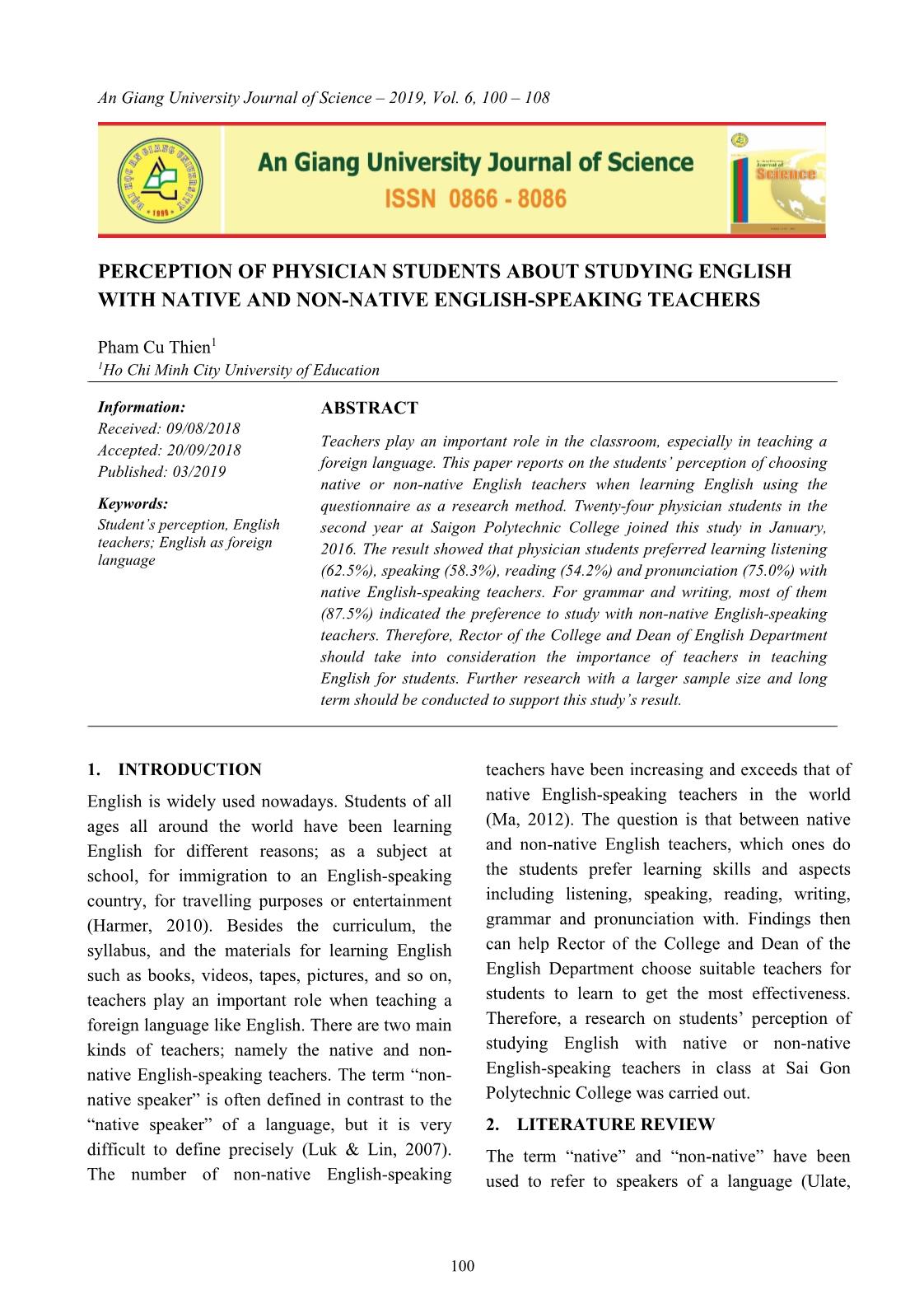
Trang 1
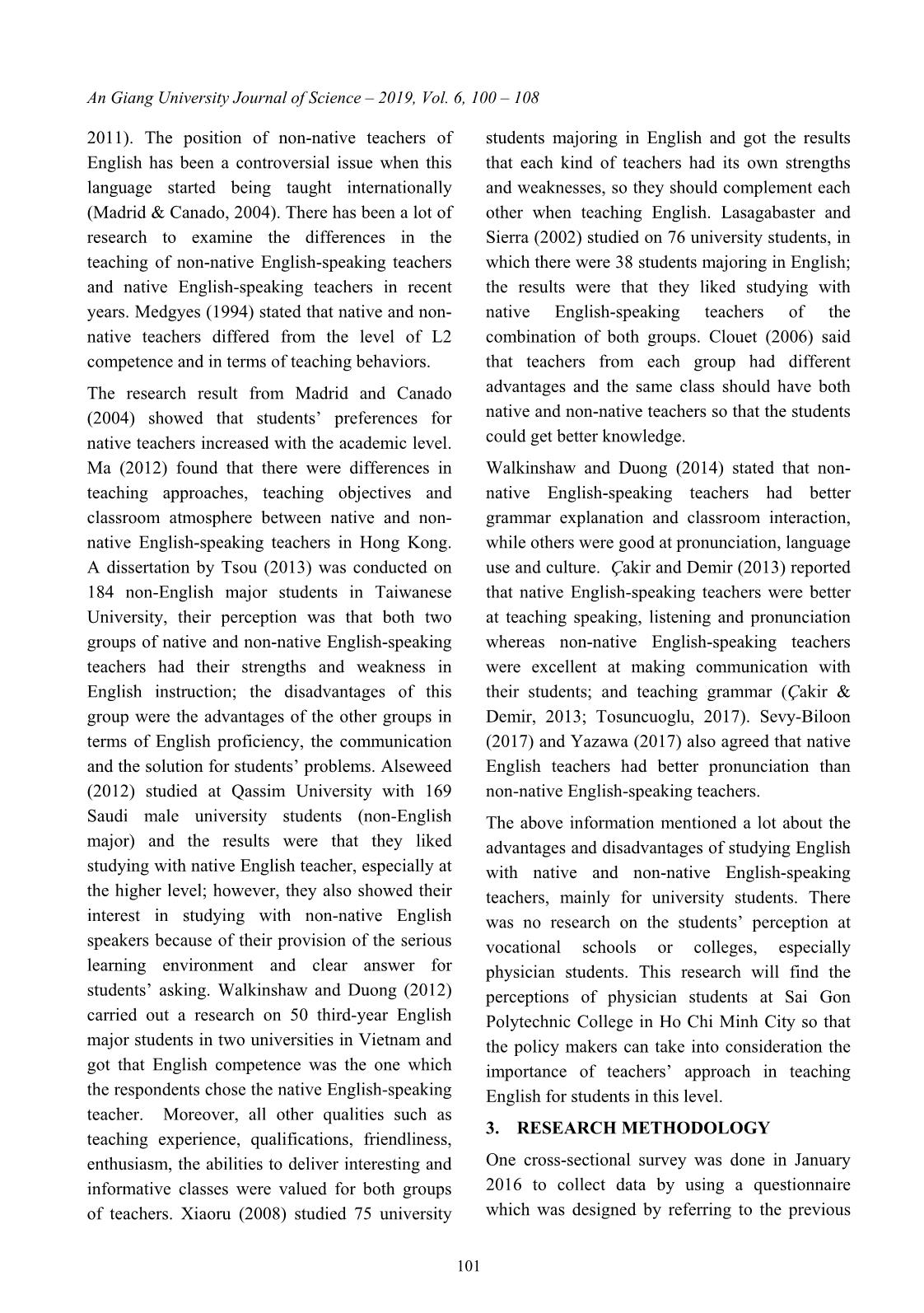
Trang 2
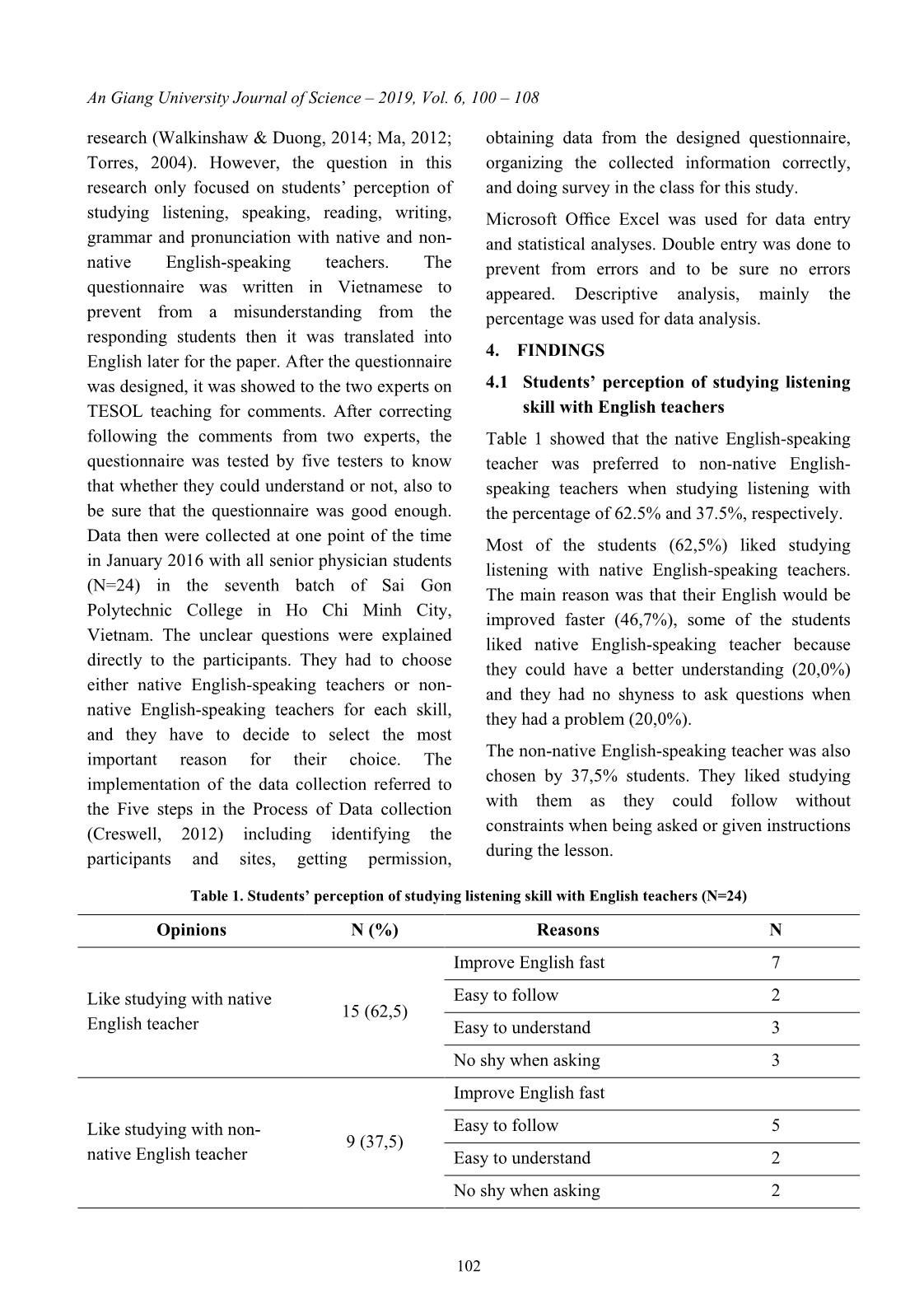
Trang 3
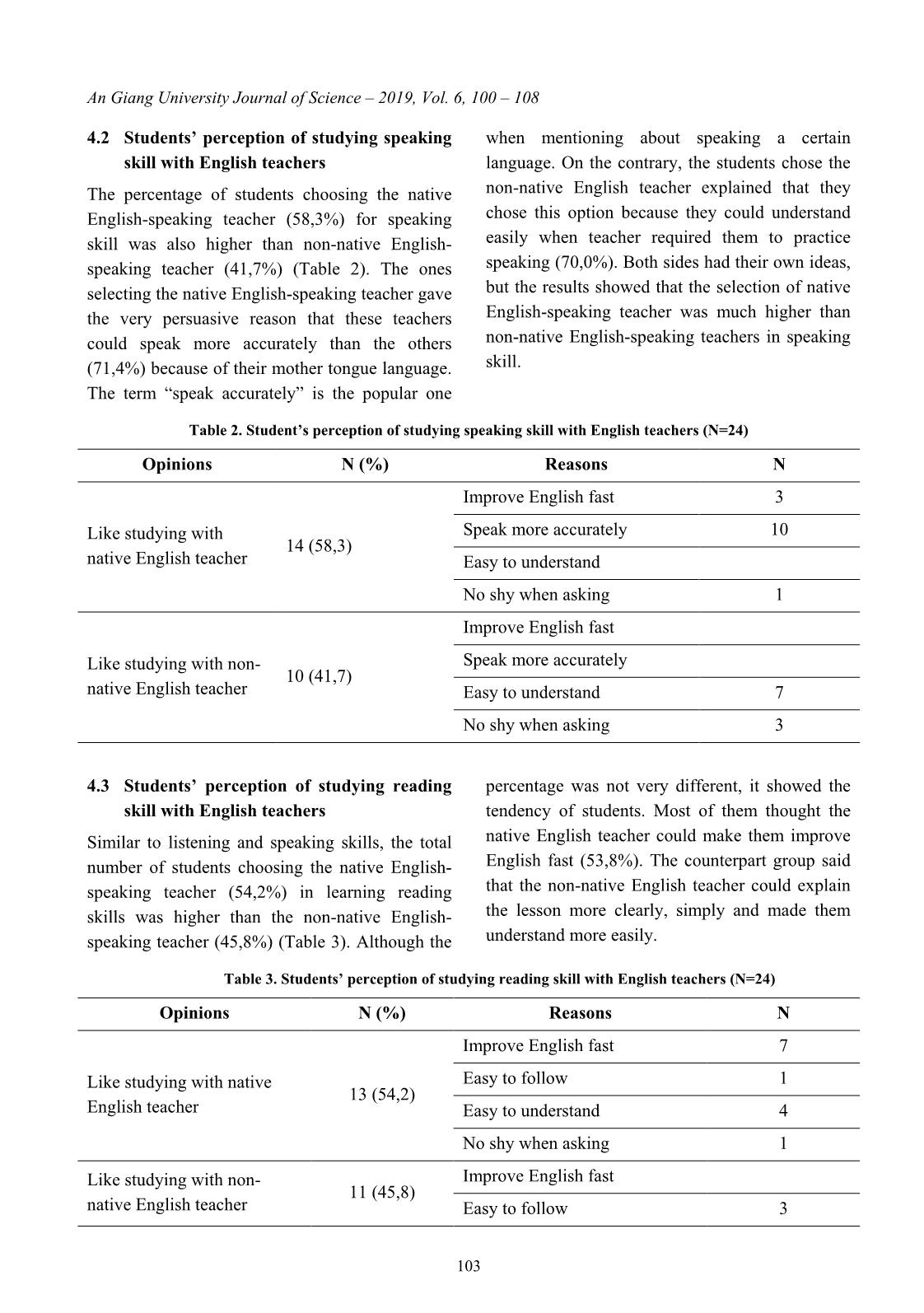
Trang 4
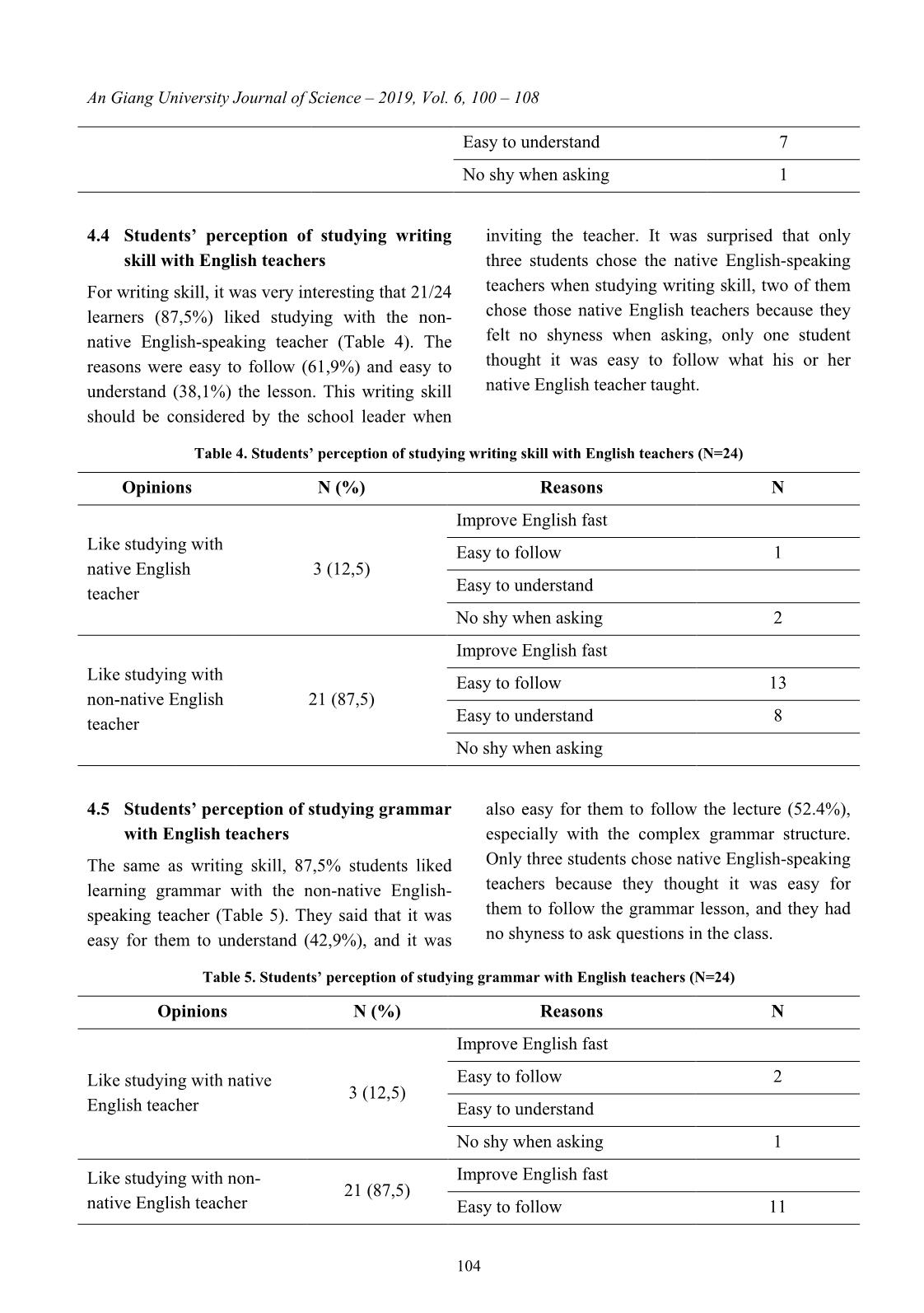
Trang 5
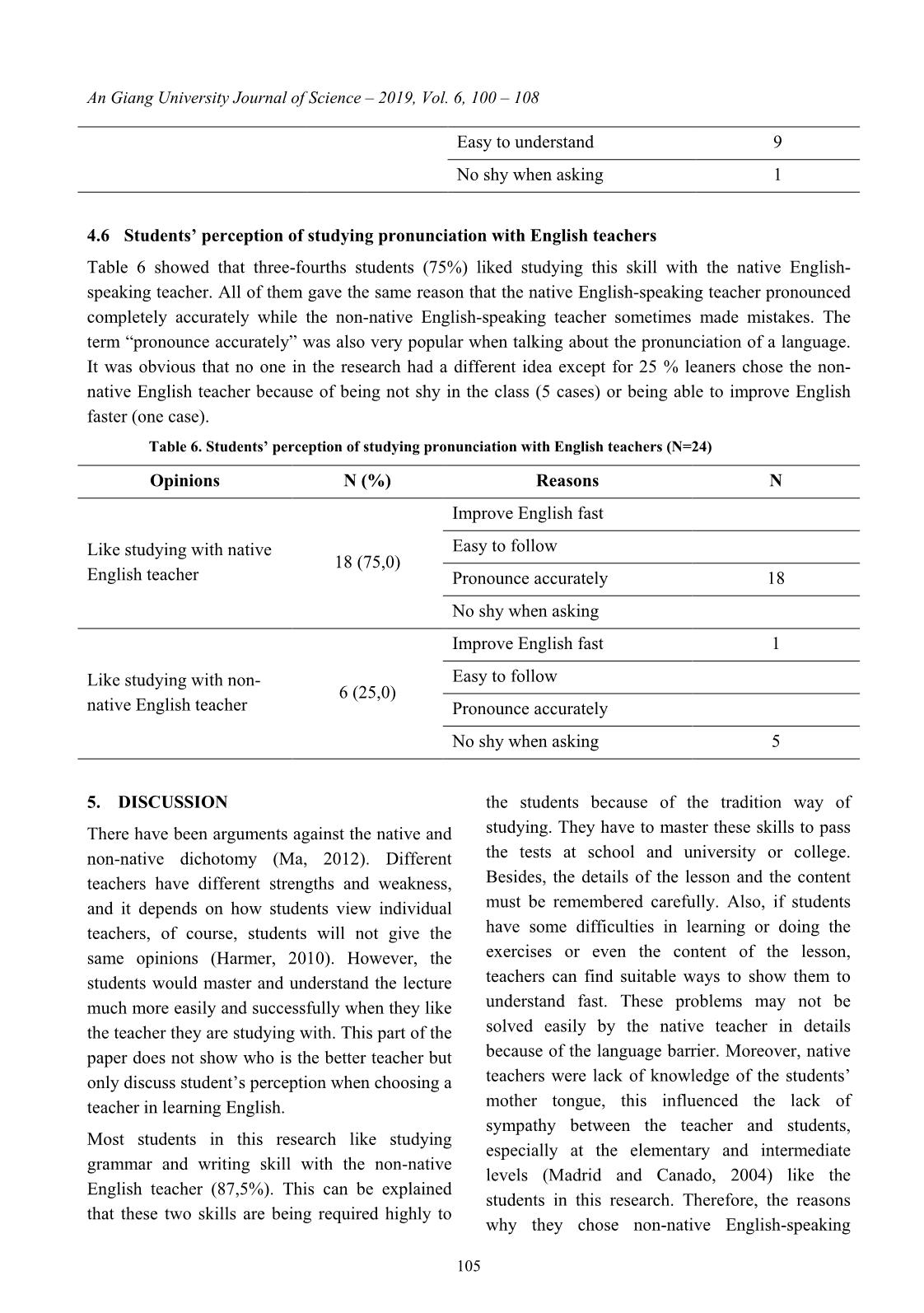
Trang 6
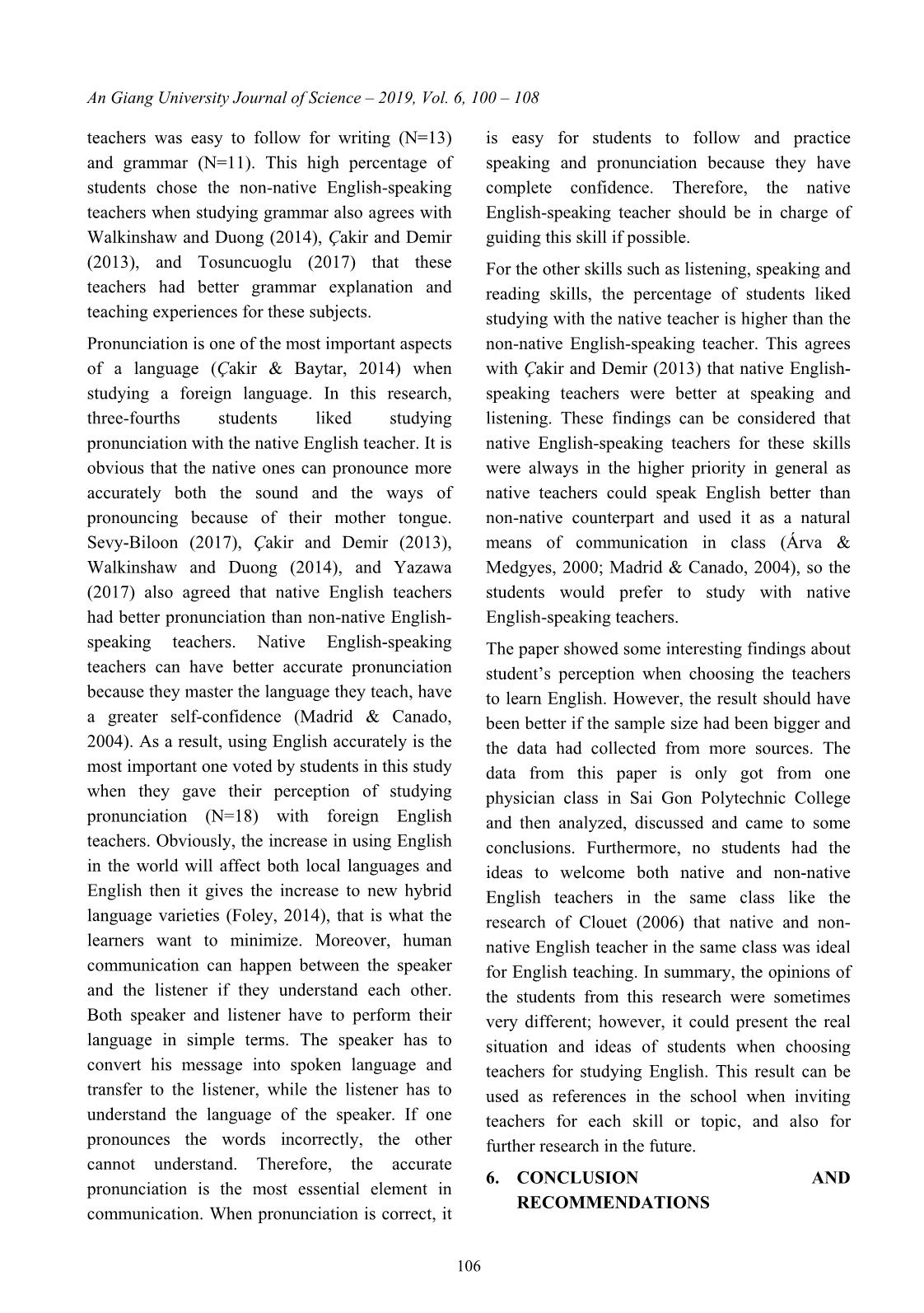
Trang 7
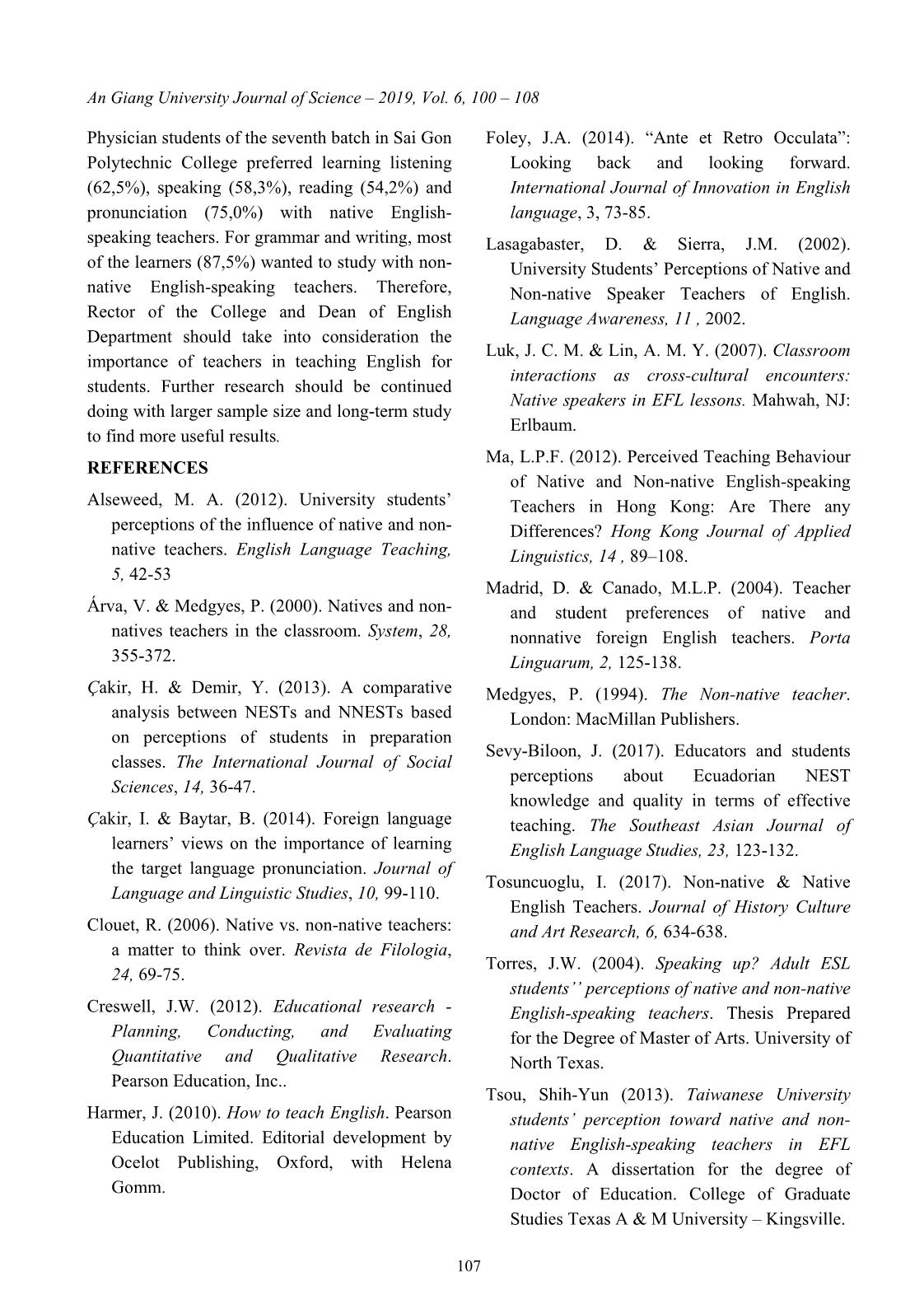
Trang 8
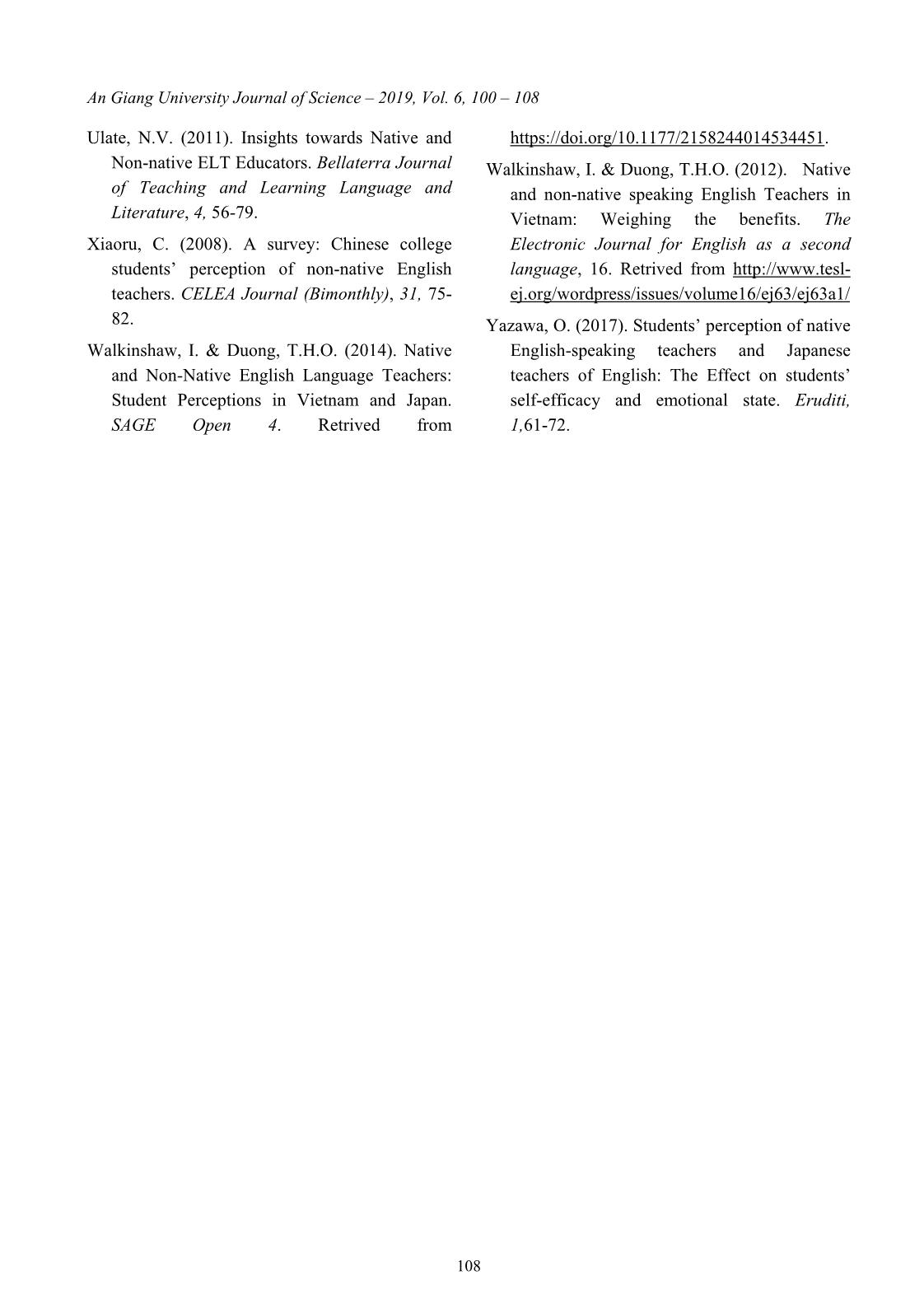
Trang 9
Tóm tắt nội dung tài liệu: Perception of physician students about studying English with native and non-native english-speaking teachers
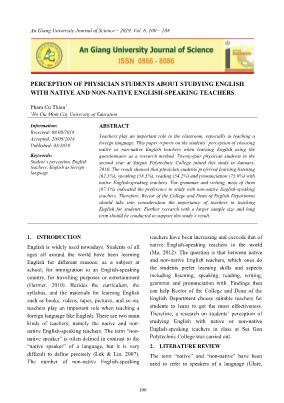
1 Like studying with non- native English teacher 10 (41,7) Improve English fast Speak more accurately Easy to understand 7 No shy when asking 3 4.3 Students’ perception of studying reading skill with English teachers Similar to listening and speaking skills, the total number of students choosing the native English- speaking teacher (54,2%) in learning reading skills was higher than the non-native English- speaking teacher (45,8%) (Table 3). Although the percentage was not very different, it showed the tendency of students. Most of them thought the native English teacher could make them improve English fast (53,8%). The counterpart group said that the non-native English teacher could explain the lesson more clearly, simply and made them understand more easily. Table 3. Students’ perception of studying reading skill with English teachers (N=24) Opinions N (%) Reasons N Like studying with native English teacher 13 (54,2) Improve English fast 7 Easy to follow 1 Easy to understand 4 No shy when asking 1 Like studying with non- native English teacher 11 (45,8) Improve English fast Easy to follow 3 An Giang University Journal of Science – 2019, Vol. 6, 100 – 108 104 Easy to understand 7 No shy when asking 1 4.4 Students’ perception of studying writing skill with English teachers For writing skill, it was very interesting that 21/24 learners (87,5%) liked studying with the non- native English-speaking teacher (Table 4). The reasons were easy to follow (61,9%) and easy to understand (38,1%) the lesson. This writing skill should be considered by the school leader when inviting the teacher. It was surprised that only three students chose the native English-speaking teachers when studying writing skill, two of them chose those native English teachers because they felt no shyness when asking, only one student thought it was easy to follow what his or her native English teacher taught. Table 4. Students’ perception of studying writing skill with English teachers (N=24) Opinions N (%) Reasons N Like studying with native English teacher 3 (12,5) Improve English fast Easy to follow 1 Easy to understand No shy when asking 2 Like studying with non-native English teacher 21 (87,5) Improve English fast Easy to follow 13 Easy to understand 8 No shy when asking 4.5 Students’ perception of studying grammar with English teachers The same as writing skill, 87,5% students liked learning grammar with the non-native English- speaking teacher (Table 5). They said that it was easy for them to understand (42,9%), and it was also easy for them to follow the lecture (52.4%), especially with the complex grammar structure. Only three students chose native English-speaking teachers because they thought it was easy for them to follow the grammar lesson, and they had no shyness to ask questions in the class. Table 5. Students’ perception of studying grammar with English teachers (N=24) Opinions N (%) Reasons N Like studying with native English teacher 3 (12,5) Improve English fast Easy to follow 2 Easy to understand No shy when asking 1 Like studying with non- native English teacher 21 (87,5) Improve English fast Easy to follow 11 An Giang University Journal of Science – 2019, Vol. 6, 100 – 108 105 Easy to understand 9 No shy when asking 1 4.6 Students’ perception of studying pronunciation with English teachers Table 6 showed that three-fourths students (75%) liked studying this skill with the native English- speaking teacher. All of them gave the same reason that the native English-speaking teacher pronounced completely accurately while the non-native English-speaking teacher sometimes made mistakes. The term “pronounce accurately” was also very popular when talking about the pronunciation of a language. It was obvious that no one in the research had a different idea except for 25 % leaners chose the non- native English teacher because of being not shy in the class (5 cases) or being able to improve English faster (one case). Table 6. Students’ perception of studying pronunciation with English teachers (N=24) Opinions N (%) Reasons N Like studying with native English teacher 18 (75,0) Improve English fast Easy to follow Pronounce accurately 18 No shy when asking Like studying with non- native English teacher 6 (25,0) Improve English fast 1 Easy to follow Pronounce accurately No shy when asking 5 5. DISCUSSION There have been arguments against the native and non-native dichotomy (Ma, 2012). Different teachers have different strengths and weakness, and it depends on how students view individual teachers, of course, students will not give the same opinions (Harmer, 2010). However, the students would master and understand the lecture much more easily and successfully when they like the teacher they are studying with. This part of the paper does not show who is the better teacher but only discuss student’s perception when choosing a teacher in learning English. Most students in this research like studying grammar and writing skill with the non-native English teacher (87,5%). This can be explained that these two skills are being required highly to the students because of the tradition way of studying. They have to master these skills to pass the tests at school and university or college. Besides, the details of the lesson and the content must be remembered carefully. Also, if students have some difficulties in learning or doing the exercises or even the content of the lesson, teachers can find suitable ways to show them to understand fast. These problems may not be solved easily by the native teacher in details because of the language barrier. Moreover, native teachers were lack of knowledge of the students’ mother tongue, this influenced the lack of sympathy between the teacher and students, especially at the elementary and intermediate levels (Madrid and Canado, 2004) like the students in this research. Therefore, the reasons why they chose non-native English-speaking An Giang University Journal of Science – 2019, Vol. 6, 100 – 108 106 teachers was easy to follow for writing (N=13) and grammar (N=11). This high percentage of students chose the non-native English-speaking teachers when studying grammar also agrees with Walkinshaw and Duong (2014), Çakir and Demir (2013), and Tosuncuoglu (2017) that these teachers had better grammar explanation and teaching experiences for these subjects. Pronunciation is one of the most important aspects of a language (Çakir & Baytar, 2014) when studying a foreign language. In this research, three-fourths students liked studying pronunciation with the native English teacher. It is obvious that the native ones can pronounce more accurately both the sound and the ways of pronouncing because of their mother tongue. Sevy-Biloon (2017), Çakir and Demir (2013), Walkinshaw and Duong (2014), and Yazawa (2017) also agreed that native English teachers had better pronunciation than non-native English- speaking teachers. Native English-speaking teachers can have better accurate pronunciation because they master the language they teach, have a greater self-confidence (Madrid & Canado, 2004). As a result, using English accurately is the most important one voted by students in this study when they gave their perception of studying pronunciation (N=18) with foreign English teachers. Obviously, the increase in using English in the world will affect both local languages and English then it gives the increase to new hybrid language varieties (Foley, 2014), that is what the learners want to minimize. Moreover, human communication can happen between the speaker and the listener if they understand each other. Both speaker and listener have to perform their language in simple terms. The speaker has to convert his message into spoken language and transfer to the listener, while the listener has to understand the language of the speaker. If one pronounces the words incorrectly, the other cannot understand. Therefore, the accurate pronunciation is the most essential element in communication. When pronunciation is correct, it is easy for students to follow and practice speaking and pronunciation because they have complete confidence. Therefore, the native English-speaking teacher should be in charge of guiding this skill if possible. For the other skills such as listening, speaking and reading skills, the percentage of students liked studying with the native teacher is higher than the non-native English-speaking teacher. This agrees with Çakir and Demir (2013) that native English- speaking teachers were better at speaking and listening. These findings can be considered that native English-speaking teachers for these skills were always in the higher priority in general as native teachers could speak English better than non-native counterpart and used it as a natural means of communication in class (Árva & Medgyes, 2000; Madrid & Canado, 2004), so the students would prefer to study with native English-speaking teachers. The paper showed some interesting findings about student’s perception when choosing the teachers to learn English. However, the result should have been better if the sample size had been bigger and the data had collected from more sources. The data from this paper is only got from one physician class in Sai Gon Polytechnic College and then analyzed, discussed and came to some conclusions. Furthermore, no students had the ideas to welcome both native and non-native English teachers in the same class like the research of Clouet (2006) that native and non- native English teacher in the same class was ideal for English teaching. In summary, the opinions of the students from this research were sometimes very different; however, it could present the real situation and ideas of students when choosing teachers for studying English. This result can be used as references in the school when inviting teachers for each skill or topic, and also for further research in the future. 6. CONCLUSION AND RECOMMENDATIONS An Giang University Journal of Science – 2019, Vol. 6, 100 – 108 107 Physician students of the seventh batch in Sai Gon Polytechnic College preferred learning listening (62,5%), speaking (58,3%), reading (54,2%) and pronunciation (75,0%) with native English- speaking teachers. For grammar and writing, most of the learners (87,5%) wanted to study with non- native English-speaking teachers. Therefore, Rector of the College and Dean of English Department should take into consideration the importance of teachers in teaching English for students. Further research should be continued doing with larger sample size and long-term study to find more useful results. REFERENCES Alseweed, M. A. (2012). University students’ perceptions of the influence of native and non- native teachers. English Language Teaching, 5, 42-53 Árva, V. & Medgyes, P. (2000). Natives and non- natives teachers in the classroom. System, 28, 355-372. Çakir, H. & Demir, Y. (2013). A comparative analysis between NESTs and NNESTs based on perceptions of students in preparation classes. The International Journal of Social Sciences, 14, 36-47. Çakir, I. & Baytar, B. (2014). Foreign language learners’ views on the importance of learning the target language pronunciation. Journal of Language and Linguistic Studies, 10, 99-110. Clouet, R. (2006). Native vs. non-native teachers: a matter to think over. Revista de Filologia, 24, 69-75. Creswell, J.W. (2012). Educational research - Planning, Conducting, and Evaluating Quantitative and Qualitative Research. Pearson Education, Inc.. Harmer, J. (2010). How to teach English. Pearson Education Limited. Editorial development by Ocelot Publishing, Oxford, with Helena Gomm. Foley, J.A. (2014). “Ante et Retro Occulata”: Looking back and looking forward. International Journal of Innovation in English language, 3, 73-85. Lasagabaster, D. & Sierra, J.M. (2002). University Students’ Perceptions of Native and Non-native Speaker Teachers of English. Language Awareness, 11 , 2002. Luk, J. C. M. & Lin, A. M. Y. (2007). Classroom interactions as cross-cultural encounters: Native speakers in EFL lessons. Mahwah, NJ: Erlbaum. Ma, L.P.F. (2012). Perceived Teaching Behaviour of Native and Non-native English-speaking Teachers in Hong Kong: Are There any Differences? Hong Kong Journal of Applied Linguistics, 14 , 89–108. Madrid, D. & Canado, M.L.P. (2004). Teacher and student preferences of native and nonnative foreign English teachers. Porta Linguarum, 2, 125-138. Medgyes, P. (1994). The Non-native teacher. London: MacMillan Publishers. Sevy-Biloon, J. (2017). Educators and students perceptions about Ecuadorian NEST knowledge and quality in terms of effective teaching. The Southeast Asian Journal of English Language Studies, 23, 123-132. Tosuncuoglu, I. (2017). Non-native & Native English Teachers. Journal of History Culture and Art Research, 6, 634-638. Torres, J.W. (2004). Speaking up? Adult ESL students’’ perceptions of native and non-native English-speaking teachers. Thesis Prepared for the Degree of Master of Arts. University of North Texas. Tsou, Shih-Yun (2013). Taiwanese University students’ perception toward native and non- native English-speaking teachers in EFL contexts. A dissertation for the degree of Doctor of Education. College of Graduate Studies Texas A & M University – Kingsville. An Giang University Journal of Science – 2019, Vol. 6, 100 – 108 108 Ulate, N.V. (2011). Insights towards Native and Non-native ELT Educators. Bellaterra Journal of Teaching and Learning Language and Literature, 4, 56-79. Xiaoru, C. (2008). A survey: Chinese college students’ perception of non-native English teachers. CELEA Journal (Bimonthly), 31, 75- 82. Walkinshaw, I. & Duong, T.H.O. (2014). Native and Non-Native English Language Teachers: Student Perceptions in Vietnam and Japan. SAGE Open 4. Retrived from https://doi.org/10.1177/2158244014534451. Walkinshaw, I. & Duong, T.H.O. (2012). Native and non-native speaking English Teachers in Vietnam: Weighing the benefits. The Electronic Journal for English as a second language, 16. Retrived from ej.org/wordpress/issues/volume16/ej63/ej63a1/ Yazawa, O. (2017). Students’ perception of native English-speaking teachers and Japanese teachers of English: The Effect on students’ self-efficacy and emotional state. Eruditi, 1,61-72.
File đính kèm:
 perception_of_physician_students_about_studying_english_with.pdf
perception_of_physician_students_about_studying_english_with.pdf

